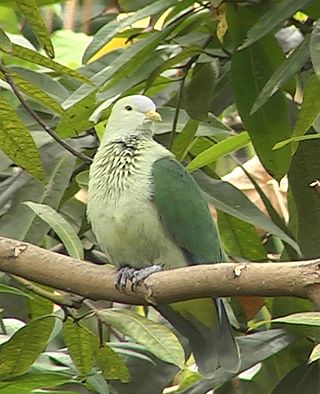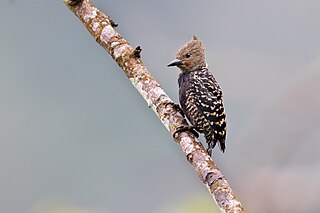
The Namaqua dove is a small pigeon. It is the only species in the genus Oena. It is found over much of Sub-Saharan Africa as well as Arabia and Madagascar.

The scaled pigeon is a large New World tropical dove. It is a resident breeder from southern Mexico south to western Ecuador, southern Brazil, northern Argentina, and Trinidad.

The zebra dove, also known as the barred ground dove, or barred dove, is a species of bird of the dove family, Columbidae, native to Southeast Asia. They are small birds with a long tail, predominantly brownish-grey in colour with black-and-white barring. The species is known for its pleasant, soft, staccato cooing calls.

The jambu fruit dove is a smallish colourful fruit dove. It is a resident breeding species in southern Thailand, Malaysia, Brunei and the Indonesian islands of Kalimantan, Sumatra and Java. It is a monotypic species.

The ruddy quail-dove is a species of bird in the dove and pigeon family Columbidae. It breeds throughout the West Indies, Central America, and tropical South America. It has appeared as a vagrant in Florida and southern Texas. It lays two buff-colored eggs on a flimsy platform built on a shrub. Some nests are built on the ground.

The orange dove or orange fruit dove is a species of bird in the pigeon family Columbidae. One of the most colorful doves, the male has a golden olive head and elongated bright orange "hair-like" body feathers. The golden-olive remiges are typically covered by the long orange wing coverts when perched. The legs, bill and orbital skin are bluish-green and the iris is whitish. The female is a dark green bird with blackish tail and orange-yellow undertail coverts. The young resemble females.

Geositta is a genus of passerine birds in the ovenbird family, Furnariidae. They are known as miners due to the tunnels they dig for nesting. There are 11 species including the campo miner which was formerly classified in a genus of its own, Geobates. They inhabit open country in South America, particularly the Andean and Patagonian regions. They are ground-dwelling birds, somewhat resembling the larks and wheatears of other continents. They are mostly drab brown in coloration and often have a fairly long and slender bill.

The Polynesian ground dove or Society Islands ground dove or Tutururu is a critically endangered species of bird in the family Columbidae. Originally endemic to the Society Islands and Tuamotus in French Polynesia, it has now been extirpated from most of its former range by habitat loss and predation by introduced species such as cats and rats, and the species is now endemic only in the Acteon islands. The total population is estimated to be around 100-120 birds.

Geotrygon is a bird genus in the pigeon and dove family (Columbidae). Its members are called quail-doves, and all live in the Neotropics. The species of this genus have ranges from southern Mexico and Central America to the West Indies and South America, with 2 species recorded as occasional vagrants reported in Texas and Florida in the United States. Quail-doves are ground-dwelling pigeons that live, nest, and feed in dense forests. They are remarkable for their vivid coloration with light-and-dark facial markings.

Leptotila is a genus of birds in the dove and pigeon family Columbidae. These are ground-foraging doves that live in the Americas.

The Caribbean dove is a species of bird in the family Columbidae. It is found in Belize, the Cayman Islands, Colombia, Honduras, Jamaica, and Mexico. It has been introduced to the Bahamas.

Macropygia is a genus of bird in the pigeon and dove family Columbidae. The genus is one of three genera known as cuckoo-doves. They are long tailed, range between 27 and 45 cm in length and have brown plumage. The genus now ranges from India and China through Indonesia and the Philippines to Vanuatu and Australia, though they originated from North and South America.

The white-headed fruit dove is a species of bird in the pigeon family Columbidae. It was described by the English ornithologist John Gould in 1856, and the specific name eugeniae honours the French empress Eugénie de Montijo. Adults of the species have white heads, a purplish-red breast patch, a grey shoulder patch, olive-green upperparts, greenish underparts with a blue tinge, and a yellowish vent. Juveniles have green heads with the white restricted to the forehead and upper throat, a much smaller grey shoulder patch, and the red breast patch restricted to the centre of the breast.

The grey-green fruit dove is a species of bird in the family Columbidae. It is endemic to the Society Islands in French Polynesia. Its natural habitat is subtropical or tropical moist lowland forests.

The claret-breasted fruit dove is a species of bird in the family Columbidae. It is found in the Moluccas, New Guinea and the Solomon Islands archipelago. Its natural habitat is subtropical or tropical moist lowland forests.

The blue-headed quail dove, or blue-headed partridge-dove, is a species of bird in the pigeon and dove family Columbidae that is endemic to the island of Cuba. It is monotypic within the subfamily Starnoenadinae and genus Starnoenas.

The zebra woodpecker is a species of bird in the family Picidae. It is found in Java. Its natural habitats are subtropical or tropical dry forests and subtropical or tropical moist lowland forests.

Columbina is a genus of small doves in the family Columbidae that live in the New World. They range from the southern United States through Central America and much of South America. Columbina doves are normally found in pairs or small flocks and generally occur in open country. They have maroon irides and pinkish legs. In flight, some species show a distinctive flash of rufous in the wings, while others show black-and-white wing-patterns.

The brown cuckoo-dove is a dove in the genus Macropygia found in Australia from Weipa and Aurukun in the north to Bega in the south, and most inland at Atherton and Toowoomba. It is sometimes called the "brown pigeon" or "pheasant pigeon", but both terms are best avoided, as they can lead to confusion with the brown doves and the true pheasant pigeon. It was one of three new species defined when the slender-billed cuckoo-dove was split in 2016.

The fruit doves, also known as fruit pigeons, are a genus (Ptilinopus) of birds in the pigeon and dove family (Columbidae). These colourful, frugivorous doves are found in forests and woodlands in Southeast Asia and Oceania. It is a large genus with over 50 species, some threatened or already extinct.




















